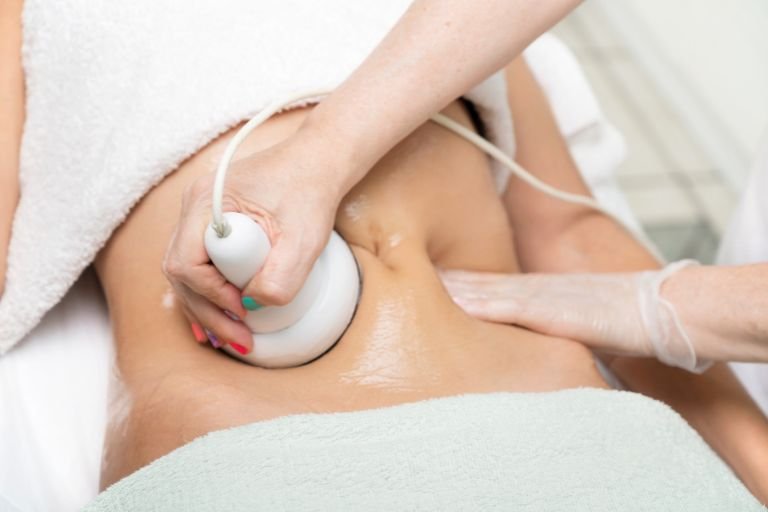- Fitwell Physiotherapy
Ultrasound Therapy

Ultrasound therapy and moist heat therapy are both commonly used modalities in physical therapy for pain relief and rehabilitation. Let’s break down each:
Please submit your details below.
Types of Ultrasound Therapy
Thermal Ultrasound Therapy:
- Purpose: Increases tissue temperature.
- Mechanism: Uses continuous sound waves to create deep heating in tissues.
- Applications: Useful for increasing blood flow, reducing muscle spasm, and enhancing tissue extensibility.
Mechanical (Non-Thermal) Ultrasound Therapy:
- Purpose: Promotes tissue healing without significant heat.
- Mechanism: Uses pulsed sound waves to produce cavitation and micro-streaming effects in tissues.
- Applications: Helps in reducing inflammation, accelerating healing, and improving cell function.
How Ultrasound Therapy is Performed
Preparation:
- The therapist applies a conductive gel to the skin over the treatment area. This gel helps to transmit the ultrasound waves efficiently.
Application:
- A handheld ultrasound device (transducer) is placed on the skin and moved in circular or linear motions.
- The transducer emits sound waves that penetrate deep into the tissues.
- The duration of the treatment typically ranges from 5 to 10 minutes, depending on the size and nature of the area being treated.
Contraindications of Ultrasound Therapy
Ultrasound therapy should be avoided in certain conditions to prevent adverse effects. Contraindications include:
- Over Growth Plates: Not recommended for use on children’s growing bones.
- Pregnancy: Avoid over the abdomen or lower back of pregnant women.
- Cancer: Not to be used over malignant tumors.
- Infection: Avoid over areas with infections.
- Vascular Issues: Not suitable for individuals with deep vein thrombosis or severe vascular conditions.
- Implants: Should not be used over areas with plastic implants or pacemakers.
What to Expect During and After Ultrasound Therapy
During Treatment:
- Patients typically feel a mild warmth or a gentle tingling sensation.
- The procedure is generally comfortable and painless.
After Treatment:
- There might be a slight redness or warmth in the treated area.
- Patients can often return to their normal activities immediately.
Benefits of Ultrasound Therapy
- Pain Relief: Helps reduce chronic and acute pain.
- Improved Blood Flow: Enhances circulation in the treated area.
- Accelerated Healing: Promotes faster tissue repair and regeneration.
- Reduced Inflammation: Decreases inflammation and swelling in affected areas.
- Enhanced Tissue Mobility: Improves flexibility and reduces stiffness in muscles and joints.
- Non-Invasive: Provides therapeutic benefits without the need for surgery or medication.
Conclusion
Ultrasound therapy is a versatile and effective treatment for a variety of musculoskeletal issues. It offers numerous benefits, including pain relief, accelerated healing, and improved tissue mobility. However, it is important to be aware of contraindications to ensure safe and effective use. Always consult with a healthcare professional before starting ultrasound therapy to determine if it is appropriate for your specific condition.
Frequently Asked Questions
Ultrasound therapy is a treatment commonly used in physical therapy to promote tissue healing and reduce pain. It works by using high-frequency sound waves, which are transmitted through a gel applied to the skin. These sound waves penetrate deep into tissues, creating a gentle heat that increases blood flow, reduces inflammation, and accelerates the healing process of muscles, tendons, and ligaments.
Ultrasound therapy can be used to treat a variety of musculoskeletal conditions, including:
- Muscle strains and sprains
- Tendonitis and tendinosis
- Ligament injuries
- Bursitis
- Arthritis
- Scar tissue management
- Soft tissue injuries
- Chronic pain conditions
Ultrasound therapy is generally considered safe when performed by a trained healthcare professional. Side effects are rare but may include mild discomfort during the treatment or temporary redness of the skin. It is important to follow the therapist’s instructions and inform them of any unusual sensations or discomfort experienced during the session.
A typical ultrasound therapy session lasts between 5 to 10 minutes, depending on the size and nature of the area being treated. The duration may vary based on the specific condition and the treatment plan designed by your therapist. Multiple sessions may be needed to achieve optimal results.
Yes, there are several contraindications for ultrasound therapy, including:
- Presence of malignant tumors (cancer)
- Areas with active infections
- Over or near areas with pacemakers or other implanted electronic devices
- Near the eyes, skull, or reproductive organs
- Over fractures or recently operated areas
- On areas with impaired blood circulation or sensation
Related Therapies
How Fitwell Physiotherapy Can Help?
Dr. Richa’s Fitwell physiotherapy has an extensive team of physiotherapists all within their own specialist areas of physiotherapy. Whatever your condition, we guarantee that we will have the best physiotherapist for you. We assess, diagnose, plan, cure and care for you.
Fitwell Physiotherapy Clinic, Pune provides you best physiotherapy treatment in Kharadi, pune. We also serve Chandan Nagar, Vadgaon Sheri, Keshav Nagar, Wagholi & nearby Areas in Pune. We are experts in treating Neck Pain, Hand Pain, Back Pain, Lower Back Pain, Knee Pain, Stiff Neck, Sciatica, Arthritis, Stroke Paralysis & Post Surgical Rehab.
We provide Specialized physiotherapy treatments in Sports Injuries, Pre and post Surgery, Neurologic, Pediatric, Chronic Pain/Fatigue, Rheumatology, Women’s Health, Men’s Health, Ergonomics, Vestibular, Amputees & all sort of Pain treatment and lifestyle conditions.



























